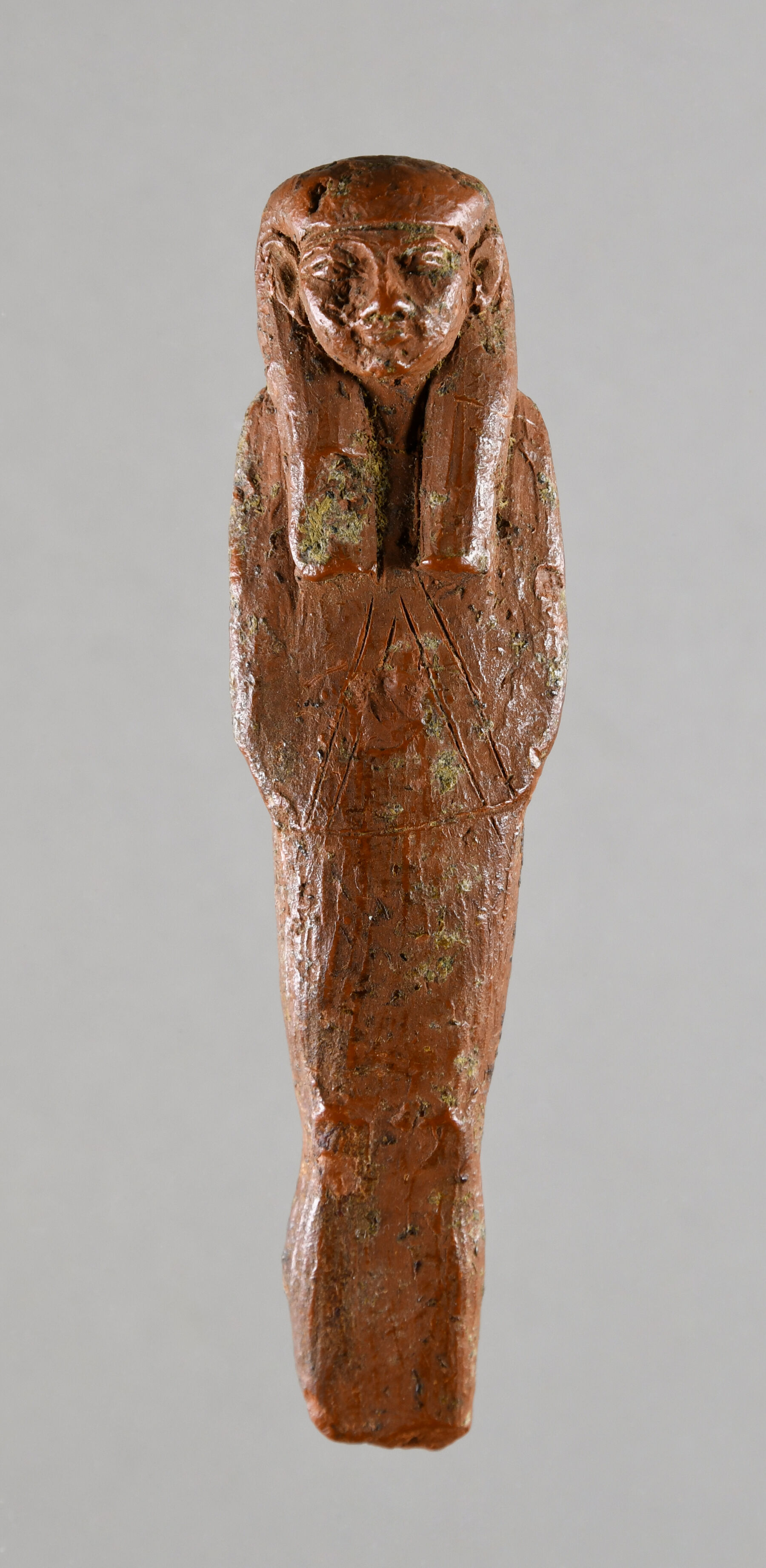This dark amber beeswax figurine once belonged to a set of the four sons of Horus, whose heads usually adorned canopic jar lids. By Dynasty 21, canopic jars were rarely used to house the embalmed organs of a deceased individual.1 Instead, the organs were embalmed, wrapped in linen, and placed at the back of the mummified body. Within each of these four linen parcels was placed a wax figure of one of the four sons of Horus.2
The god Imsety protected the liver. His human head is carefully modeled, and he wears a lappet wig. The remains of his protruding elbows suggest the arms were once crossed. The figurine has incised crossed bands at the front and back and an etched horizontal band at the waist.3
EW
-
Raven, Maarten J. 1983. “Wax in Egyptian magic and symbolism.” Oudheidkundige Mededelingen uit het Rijksmuseum van Oudheden 64: 7-47.; D’Auria, Sue, Peter Lacovara, and Catharine H. Roehrig, eds. 1988. Mummies & magic: the funerary arts of ancient Egypt. Boston: Museum of Fine Arts.; Grajetzki, Wolfram. 2003. Burial Customs in Ancient Egypt: Life in Death for Rich and Poor. Bristol: Bristol Classical Press.. ↩︎
-
Varga, Edith. 1964. Les monuments d’une coutume funéraire égyptienne de basse époque. Bulletin du Musée Hongrois des Beaux-Arts 25: 3-17, 123-132.; Raven, Maarten J. 1983. “Wax in Egyptian magic and symbolism.” Oudheidkundige Mededelingen uit het Rijksmuseum van Oudheden 64: 7-47.; Aston, David A. 2009. Burial Assemblages of Dynasty 21-25: Chronology - Typology - Developments. Contributions to the Chronology of the Eastern Mediterranean 21; Österreichische Akademie der Wissenschaften, Denkschriften der Gesamtakademie 54. Vienna: Österreichische Akademie der Wissenschaften.. ↩︎
-
Aston, David A. 2009. Burial Assemblages of Dynasty 21-25: Chronology - Typology - Developments. Contributions to the Chronology of the Eastern Mediterranean 21; Österreichische Akademie der Wissenschaften, Denkschriften der Gesamtakademie 54. Vienna: Österreichische Akademie der Wissenschaften., notes that these figures can be modeled in the round or have flat backs. ↩︎
Bibliography
- Aston 2009
- Aston, David A. 2009. Burial Assemblages of Dynasty 21-25: Chronology - Typology - Developments. Contributions to the Chronology of the Eastern Mediterranean 21; Österreichische Akademie der Wissenschaften, Denkschriften der Gesamtakademie 54. Vienna: Österreichische Akademie der Wissenschaften.
- D’Auria, Lacovara, and Roehrig 1988
- D’Auria, Sue, Peter Lacovara, and Catharine H. Roehrig, eds. 1988. Mummies & magic: the funerary arts of ancient Egypt. Boston: Museum of Fine Arts.
- Grajetzki 2003
- Grajetzki, Wolfram. 2003. Burial Customs in Ancient Egypt: Life in Death for Rich and Poor. Bristol: Bristol Classical Press.
- Raven 1983
- Raven, Maarten J. 1983. “Wax in Egyptian magic and symbolism.” Oudheidkundige Mededelingen uit het Rijksmuseum van Oudheden 64: 7-47.
- Varga 1964
- Varga, Edith. 1964. Les monuments d'une coutume funéraire égyptienne de basse époque. Bulletin du Musée Hongrois des Beaux-Arts 25: 3-17, 123-132.
